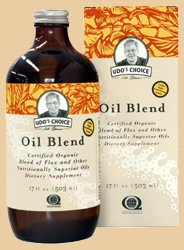|
|


This premium-quality
product has a pleasant light nutty flavor and is easily mixed with
health shakes, protein drinks, or, added as a topping to salads
and vegetables!
DOWNLOAD
THE PDF FILE ON UDO'S CHOICE™ OIL BLEND! (1.2Meg)
please note you will need Adobe Acrobat Reader or similar PDF client installed.
Scientists have given
essential fats (a.k.a. essential fatty acids or EFAs) their name
because the body
must have them to survive, but cannot synthesize them from any
other substance we eat, so a direct food source is required. Hence,
the name essential. There are many kinds of fats, but only
two kinds of essential fats: omega 3 (omega-3 or w3) and omega 6
(omega-6 or w6), both of which are unsaturated fats. Each EFA is
turned into several derivatives by the body, provided enough omega-3
and omega-6, in the right ratio, and made with health in mind, are
supplied. All other fats, such as omega 9 (monounsaturated), omega
7, and saturated fat, are non-essential because the body can produce
them from sugars and starches.

Sources of omega-3s are flaxseeds
and green leafy vegetables. The omega-3 derivatives EPA and
DHA are found in high fat, cold water fish such as albacore tuna,
sardines, Atlantic halibut and salmon, coho, pink and king salmon,
Pacific and Atlantic herring, Atlantic mackerel, and lake trout.
Small amounts of EPA and DHA omega-3s are also found in oysters and
other shellfish.
Omega-6 is found in sesame and sunflower seeds and other seeds and nuts. Land
animal meats and fish are sources of the omega-6 derivative arachidonic acid (AA).
The
fish listed above are preferred sources of omega-3 and omega-6 derivatives, because
they are the richest sources, and contain both, with more omega-3s.
Just as a member of a large family
has many roles, essential fats serve many functions in the
complex workings of the human body. Taken in the right amounts
and ratios, and taken from the right sources, essential fats
help establish and maintain health as follows . . .
 Increase energy,
performance, and stamina. EFAs enhance thermogenesis,
help build muscle, prevent muscle break down, and speed recovery
from fatigue;
Strengthen the immune
system. EFAs make hormone-like eicosanoids that regulate
immune and inflammatory responses. Omega-3s have anti-inflammatory
effects and can slow autoimmune damage;
Lower most risk factors
for cardiovascular disease. EFAs (especially n3s) lower
abnormally high levels of blood pressure, triglycerides,
Lp(a), fibrinogen, tendency to clot formation, and inflammation;
Improve brain function:
mood, intelligence , behavior, and vision. Our brain
is over 60% fat. EFAs are important components of the entire
nervous system. They are necessary to make the neurotransmitter
serotonin. Depression and other brain diseases show decreased
levels of omega-3;
Aid in weight reduction.
EFAs help keep mood and energy up and suppress appetite, thereby
aiding in weight loss. More recently, they have been found
to block the genes that produce fat in the body (saturated
and Trans Fat do not have this same effect) and
increase thermogenesis;
Regulate organs and
glands. Liver and kidneys, adrenal and thyroid glands,
and the production of male and female hormones need EFAs;
Speed recovery and
healing. EFAs are necessary for cell growth and division.
They form all cell membranes and regulate vital cell activity;
Support healthy child
development. For nervous system development, a growing
fetus needs optimum EFAs from the mother's body. Mothers
become depleted of EFAs during pregnancy, and need optimal
EFA intake for their health and their children's optimum
development;
Increase energy,
performance, and stamina. EFAs enhance thermogenesis,
help build muscle, prevent muscle break down, and speed recovery
from fatigue;
Strengthen the immune
system. EFAs make hormone-like eicosanoids that regulate
immune and inflammatory responses. Omega-3s have anti-inflammatory
effects and can slow autoimmune damage;
Lower most risk factors
for cardiovascular disease. EFAs (especially n3s) lower
abnormally high levels of blood pressure, triglycerides,
Lp(a), fibrinogen, tendency to clot formation, and inflammation;
Improve brain function:
mood, intelligence , behavior, and vision. Our brain
is over 60% fat. EFAs are important components of the entire
nervous system. They are necessary to make the neurotransmitter
serotonin. Depression and other brain diseases show decreased
levels of omega-3;
Aid in weight reduction.
EFAs help keep mood and energy up and suppress appetite, thereby
aiding in weight loss. More recently, they have been found
to block the genes that produce fat in the body (saturated
and Trans Fat do not have this same effect) and
increase thermogenesis;
Regulate organs and
glands. Liver and kidneys, adrenal and thyroid glands,
and the production of male and female hormones need EFAs;
Speed recovery and
healing. EFAs are necessary for cell growth and division.
They form all cell membranes and regulate vital cell activity;
Support healthy child
development. For nervous system development, a growing
fetus needs optimum EFAs from the mother's body. Mothers
become depleted of EFAs during pregnancy, and need optimal
EFA intake for their health and their children's optimum
development; Improve digestion.
Poorly digested foods tie up the immune system and can cause
gut inflammation, leaky gut, and allergies. Omega-3s improve gut
integrity, and decrease inflammation and "leaky gut";
Decrease infection.
EFAs have anti-fungal, anti-yeast, and anti-microbial properties,
helping to protect against infections;
Keep bones strong.
EFAs aid in the transport of minerals that keep bones and teeth
strong, helping to prevent osteoporosis;
Protect genetic material.
EFAs regulate gene expression, and omega-3s inhibit tumor growth;
Ease PMS. Studies
indicate that omega-6 (GLA) intake was voted, by women, among the
top three most effective PMS treatments. Omega-3s may be even more
effective;
Produce beautiful
skin, hair, and nails. Some of the first signs of EFA
deficiency are dry, flaky skin, dull hair, and brittle nails.
omega-3s can help skin conditions such as eczema, psoriasis,
and acne. Also, GLA (omega-6 derivative) administration is useful
for some patients with atopic eczema.
Improve digestion.
Poorly digested foods tie up the immune system and can cause
gut inflammation, leaky gut, and allergies. Omega-3s improve gut
integrity, and decrease inflammation and "leaky gut";
Decrease infection.
EFAs have anti-fungal, anti-yeast, and anti-microbial properties,
helping to protect against infections;
Keep bones strong.
EFAs aid in the transport of minerals that keep bones and teeth
strong, helping to prevent osteoporosis;
Protect genetic material.
EFAs regulate gene expression, and omega-3s inhibit tumor growth;
Ease PMS. Studies
indicate that omega-6 (GLA) intake was voted, by women, among the
top three most effective PMS treatments. Omega-3s may be even more
effective;
Produce beautiful
skin, hair, and nails. Some of the first signs of EFA
deficiency are dry, flaky skin, dull hair, and brittle nails.
omega-3s can help skin conditions such as eczema, psoriasis,
and acne. Also, GLA (omega-6 derivative) administration is useful
for some patients with atopic eczema.
Of
all the essential nutrients, essential
fats are by far the
most abused because they are perishable, chemically unstable
foods. Almost all supermarket oils, including the
oils used in processed foods, have been damaged by destructive
processing
techniques, including refining, bleaching, overheating,
and/or partial hydrogenation (a process which produces deadly trans fats).

By now, it may be clear
that everybody needs essential fats.
Omega-3 consumption has decreased
to one sixth the level found in our food supply in the
1850s. Omega-6 consumption has doubled in that time, drastically changing
the ratio of omega-6 to omega-3 in our food supply. This change is reflected in the
makeup of our tissue fats and in our health. That means that while both omega-3s
and omega-6s are required by every cell, we get too much omega-6 and far too little
omega-3. For this reason, research shows that omega-3s help in more than twice
as many degenerative diseases than do omega-6s.
More recently (the last 20
years), 'low' fat, 'no' fat, and 'fake' fat diets have been
depriving people of both essential fats. Deficiency leads
to deterioration of every cell, tissue, gland, organ and organ
system and, by extension, to symptoms of deficiency that accompany
loss of health.
 In 1994, a Harvard School of Public Health press release warned
the consumers on the dangers of eating trans fatty acids
found in some margarines, most commercially baked goods, and
deep-frying oils, including oils used in restaurants. On June
23, 1999, they again announced a press release on the most recent trans fat
research. It was titled: "Harvard review of evidence verifies
that eating trans fats increases risk of heart disease".
Head author, Alberto Ascherio, revealed that "...if trans fats
were replaced by unsaturated vegetable oils, we would expect
to see at least 30,000 fewer persons die prematurely from CHD
(coronary heart disease) each year." That
number was based on the United States alone! In 1994, a Harvard School of Public Health press release warned
the consumers on the dangers of eating trans fatty acids
found in some margarines, most commercially baked goods, and
deep-frying oils, including oils used in restaurants. On June
23, 1999, they again announced a press release on the most recent trans fat
research. It was titled: "Harvard review of evidence verifies
that eating trans fats increases risk of heart disease".
Head author, Alberto Ascherio, revealed that "...if trans fats
were replaced by unsaturated vegetable oils, we would expect
to see at least 30,000 fewer persons die prematurely from CHD
(coronary heart disease) each year." That
number was based on the United States alone!
The omega-3 essential fat alpha-linolenic acid (LNA) is damaged
5 times more quickly than the omega-6. This
makes it a manufacturer's nightmare, unless great care
is
taken to protect it during manufacture, storage (and home use too). Unfortunately,
fish oils are destroyed 5 times more rapidly than even LNA. This is why fish
oils smell and taste fishy (which is rancidity) and why eating fresh fish at
the sushi bar to get the health-benefiting EPA and DHA is preferable to capsules
of EPA or DHA-rich oils from fish.
See the book Fats
That Heal Fats That Kill (456p.) for the complete story
on fats, oils, and our health.
Oils made with health in mind come from organically
grown seeds. They are pressed under protection from
heat, light, and oxygen; packaged in tightly sealed brown glass
bottles; placed in a light-excluding box; and stored in
the fridge. Oils made with this care - the highest possible
quality - are mostly found in health food stores and naturopathic
physician offices, although some department stores and specialty
stores are now also servicing their customers.
Made with exceptional
care, this Oil
Blend was developed for people who want one product that gives
them all the good fats they need, without any of the bad fats
they should avoid.
Used in the right
amounts and ratios, essential fats confer invaluable health
benefits. 1 to 5 Tbsp/day of Udo's Choice Perfected 3, 6, 9
Oil Blend will make skin soft and velvety. For serious conditions,
seek advice of a nutritionally trained health care professional.
Udo's Choice Oil Blend is compatible
with all foods and can be used with cold,
warm, and hot (once off the heat source) foods but must not be used
for frying, baking, or other high temperature cooking. Favorite uses are
in salads, protein shakes, yogurt, juices, soups, on steamed vegetables, rice,
and pastas, and with balsamic vinegar for dipping.
Sealed Udo's Choice Oil Blend bottles can be kept for up to eight months refrigerated
and for over two years in the freezer (oil shrinks when frozen so the glass
bottles will not break). For freshness, the oil is best used within eight weeks
of opening the bottle.

Udo's Choice Perfected (Ultimate) 3,
6, 9 Oil Blend is a certified organic blend of guaranteed
GMO-free, unrefined edible oils. This unique blend delivers
a reliable source of the omega-3 and omega-6 essential fatty acids
that are essential to life. Based on 15 years of practical
experience with fats and oils, this formula is a 2:1:1 ratio
of omega-3: omega-6: n-9, a combination most therapeutic for the omega-3-deficient,
omega-6-rich diets, as well as 'low' and 'no' fat diets, common
today. The Perfected Oil Blend includes oils from fresh flax,
sesame and sunflower seeds, as well as oils from evening primrose,
rice germ and oat germ.
 This blend
is rich in GMO-free lecithin, which provides the building
materials for healthy cell membranes. The formula
used to include medium chain triglycerides (MCTs), which
are
easy to digest and assimilate, but are not available
in an organic form. These were recently replaced by organic
coconut oil, which contains MCTs with powerful antimicrobial
effects, and powerful antioxidants. The blend also contains
the potent antioxidant tocotrienols (from rice). The
MCTs in the coconut oil are used directly by our cells
as an energy source without increasing fat deposits.
Vitamin E and rosemary oil, both potent antioxidants,
are added
to increase freshness and to act as scavengers of free
radical molecules in the body. This blend
is rich in GMO-free lecithin, which provides the building
materials for healthy cell membranes. The formula
used to include medium chain triglycerides (MCTs), which
are
easy to digest and assimilate, but are not available
in an organic form. These were recently replaced by organic
coconut oil, which contains MCTs with powerful antimicrobial
effects, and powerful antioxidants. The blend also contains
the potent antioxidant tocotrienols (from rice). The
MCTs in the coconut oil are used directly by our cells
as an energy source without increasing fat deposits.
Vitamin E and rosemary oil, both potent antioxidants,
are added
to increase freshness and to act as scavengers of free
radical molecules in the body.
 Carefully chosen, the seeds
used to make Udo's Choice Perfected 3, 6, 9 Oil Blend
are pressed at a temperature of less than 120°F (or 50°C) and,
even more important, in the absence of light and oxygen. Nitrogen-flushed,
amber glass bottles packaged in a box and found only in the fridge or freezer,
protects this Oil Blend from potential damage by heat, light and oxygen, and
helps to ensure maximum freshness and stability. Carefully chosen, the seeds
used to make Udo's Choice Perfected 3, 6, 9 Oil Blend
are pressed at a temperature of less than 120°F (or 50°C) and,
even more important, in the absence of light and oxygen. Nitrogen-flushed,
amber glass bottles packaged in a box and found only in the fridge or freezer,
protects this Oil Blend from potential damage by heat, light and oxygen, and
helps to ensure maximum freshness and stability.
 Along with the invaluable health benefits blended
essential fats confer when taken internally, external application has
also proven to be of benefit for nice skin. In the January 2000 issue of the
UK fashion magazine, Tatler,
alternative health guru, Leslie Kenton, explains "I cover my face and body
religiously with Udo's Choice Oil." Along with the invaluable health benefits blended
essential fats confer when taken internally, external application has
also proven to be of benefit for nice skin. In the January 2000 issue of the
UK fashion magazine, Tatler,
alternative health guru, Leslie Kenton, explains "I cover my face and body
religiously with Udo's Choice Oil."
The Udo's Choice Perfected Oil Blend won the Gold Alive Award each year it
was entered, each time in a different category (1996, 1997, 1999, 2000).
- organic flax seed oil;
- organic sunflower seed
oil;
- organic sesame seed
oil;
- rice and oat germ oils;
- organic coconut oil;
- organic evening primrose
oil;
- lecithin (guaranteed
GMO-free);
- vitamin E;
- antioxidants (tocotrienols);
and
- rosemary oil.
- 65mg of phytosterols/tablespoon
(lower cholesterol and normalize immune function);
- lignans (beneficial
phytoestrogens from flax);
- carotene; and
- tocotrienols and other
seed specific antioxidants.
- hundreds of other oil-soluble,
health-benefiting phytonutrients
References:
- Holman RT, The slow
discovery of the importance of omega 3 essential fatty
acids in human health. J Nutr 1998 Feb;128(2 Suppl):427S-433S.
Hormel Institute, University of Minnesota, Austin 55912,
USA.
- Campbell, Neil A., Biology,
Fourth Edition. The Benjamin Cummings Publishing Co. Inc.,
1996.
- Wardlaw, Gordon
M., Perspectives in Nutrition, Fourth Edition. WCB/McGraw-Hill,
1999.
- Schmidt, Michael
A., Smart Fats: How Dietary Fats and Oils Affect Mental,
Physical, and Emotional Intelligence. Frog, Ltd., 1997.
- Hui, Y.H. (editor),
Bailey's Industrial Oil and Fat Products, Fifth Edition,
Volume 1. Edible Oil and Fat Products: General Applications.
John Wiley & Sons, Inc., 1996.
- Hui, Y.H. (editor),
Bailey's Industrial Oil and Fat Products, Fifth Edition,
Volume 2. Edible Oil and Fat Products: Oils and Oil Seeds.
John Wiley & Sons, Inc., 1996.
- Hui, Y.H. (editor),
Bailey's Industrial Oil and Fat Products, Fifth Edition,
Volume 3. Edible Oil and Fat Products: Products and Application
Technology. John Wiley & Sons, Inc., 1996.
- Hui, Y.H. (editor),
Bailey's Industrial Oil and Fat Products, Fifth Edition,
Volume 4. Edible Oil and Fat Products: Processing Technology.
John Wiley & Sons, Inc., 1996.
- Campbell EM, et
al., Premenstrual symptoms in general practice patients.
Prevalence and treatment. J Reprod Med 1997 Oct;42(10):637-46.
Hunter Center for Health Advancement, Wallsend, NSW, Australia.
- Kruger MC, Horrobin
DF., Calcium metabolism, osteoporosis and essential fatty
acids. Prog Lipid Res 1997 Sep;36(2-3):131-51. Department
of Physiology, University of Pretoria, South Africa.
- Mayser P, et al.,
Omega-3 fatty acid-based lipid infusion in patients with
chronic plaque psoriasis: results of a double-blind, randomized,
placebo-controlled, multicenter trial. J Am Acad Dermatol 1998
Apr;38(4):539-47. Department of Dermatology and Andrology,
Justus Leibig University Giessen, Germany.
- Grattan C, et al.,
Essential-fatty-acid metabolites in plasma phospholipids
in patients with ichthyosis vulgaris, acne vulgaris, and
psoriasis. Clin Exp Dermatol 1990 May;15(3):174-6.
Department of Dermatology, General Hospital, Birmingham,
UK.
- Heller A, et al.,
Lipid mediators in inflammatory disorders. Drugs 1998
Apr;55(4):487-96. Department of Anaesthesiology and Intensive
Care Medicine, University of Dresden, Germany.
- Eynard AR., Does
chronic essential fatty acid deficiency constitute a pro-tumorigenic
condition?. Med Hypotheses 1997 Jan;48(1):55-62.
Institute of Cellular Biology, Facultad de Ciencias Medicas,
Cordoba, Argentina.
- Fan YY, Chapkin
R.S., Importance of dietary gamma-linolenic acid in human
health and nutrition. J Nutr 1998;128(9):1411-4.
Faculty of Nutrition, Molecular Cell Biology Group, Texas
A&M University, College Station, TX. 77843-2471, USA.
- Edwards R, et al.,
Omega-3 polyunsaturated fatty acid levels in the diet and
in red blood cell membranes of depressed patients. J
Affect Disord 1998 Mar;48(2-3):149-55.
- Grimsgaard S, et
al., Plasma saturated and linoleic fatty acids are independently
associated with blood pressure. Hypertension 1999
Sep;34(3):478-83. Institute of Community Medicine, University
of Tromso, Norway.
- Marcovina SM, et
al., Fish intake, independent of apo(a) size, accounts
for lower plasma lipoprotein(a) levels in Bantu fishermen
of Tanzania: The Lugalawa Study. Arterioscler Thromb
Vasc Biol 1999 May;19(5):1250-6. Department of Medicine,
University of Washington, Seattle, USA.
- German JB., Food
processing and lipid oxidation. Adv Exp Med Biol 1999;459:23-50.
Department of Food Science and Technology, University of
California, Davis 95616, USA.
- Hardy SC, Kleinman
R.E., Fat and cholesterol in the diet of young children:
implications for growth, development, and long-term health. J
Pediatr 1994 Nov;125(5 PT 2):S69-77. Combined Program
in Pediatric Gastroenterology and Nutrition, Massachusetts
General Hospital, Boston 02113.
- Fernandes G, Troyer
DA, Jolly Ca., The effects of dietary lipids on gene expression
and apoptosis. Proc Nutr Soc 1998 Nov;57(4):543-50.
Department of Medicine, University of Texas Health Science
Center at San Antonio 78284-7874, USA.
- Harbige L.S., Dietary
omega-6 and omega-3 fatty acids in immunity and autoimmune disease. Proc
Nutr Soc 1998 Nov;57(4):555-62. School of Chemical
Life Sciences, University of Greenwich, London, UK.
- Redgrave T.G., Lipids
in Enteral Nutrition. Curr Opin Clin Nutr Metab Care 1999
Mar;2(2):147-52. University of Western Australia, Nedlands,
Perth, Australia.
- Clandinin, M.T.,
Brain development and assessing the supply of polyunsaturated
fatty acids. Lipids 1999 Feb;34(2):131-7. Nutrition
and Metabolism Research Group, Department of Agriculture,
Food and Nutritional Science, University of Alberta, Edmonton,
Canada.
- Melanson KJ, et
al., Blood glucose patterns and appetite in time-blinded
humans: carbohydrate versus fat. Am J Physiol 1999
Aug;277(2 Pt 2):R337-45. Department of Human Biology, Maastricht
University, 6200 MD Maastricht, The Netherlands.
- Stan S, et al.,
Modulation of apo A-IV transcript levels and synthesis
by omega-3, omega-6, and n-9 fatty acids in CACO-2 cells. J
Cell Biochem 1999 Oct 1;75(1):73-81. Department of
Nutrition, Biochemistry and Pathology Research Centre,
Sainte-Justine Hospital, Montreal University, Quebec, Canada.
- Matthys LA, Widmaier
E.P., Fatty acids inhibit adrenocorticotropin-induced adrenal
steroidogenesis. Horm Metab Res 1998 Feb;30(2):80-3.
University of Tennessee School of Medicine, Memphis, USA.
- Sircar S, Kansra
U, Choice of cooking oils--myths and realities. J Indian
Med Assoc 1998 Oct;96(10):304-7. Department of Medicine,
Safdarjang Hospital, New Delhi.
- Horrobin DF, Essential
fatty acid metabolism and its modification in atopic eczema. Am
J Clin Nutr 2000 Jan;71(1 Suppl):367S-72S. Laxdale
Research, Stirling, Scotland, United Kingdom.
- Haggans et al.,
Effect of flaxseed consumption on urinary estrogen matabolites
in postmenopausal women. Nutr Cancer 1999;33(2):188-95.
Department of Food Science and Nutrition, University of
Minnesota, St. Paul 55108, USA.
- Harvard School
of Public Health Press Release, June 23, 1999. Harvard
review of evidence verifies that eating trans fats
increases risk of heart disease. Boston, MA, USA.
- Harvard School
of Public Health Pres Release, November 18, 1997.
Study shows how different types of dietary fat affect
coronary heart disease risk. Boston, MA, USA.
- Ascherio A, Willett
WC, Health effects of Trans Fatty acids. Am J
Clin Nutr 1997 Oct;66(4 Suppl):1006S-1010S. Department
of Nutrition, Harvard School of Public Health, Boston,
MA, 02115, USA.
- Bloom, M., et al., Insights
from NMR on the Functional Role of Polyunsaturated Lipids
in the Brain, 1999. Canadian Institute for Advanced
Research, Department of Physics and Astronomy, University
of British Columbia, Vancouver, BC, V6T 1Z1, Canada.
- Simopoulos, A.P.,
Essential fatty acids in health and chronic disease. Am
J Clin Nutr 1999 Sept;70(3 Suppl):560S-569S. Center
for Genetics, Nutrition and Health, Washington DC 20009.
- Kankaanpaa, P.,
et al., Dietary fatty acids and allergy. Ann Med 1999
Aug;31(4):282-7. Department of Boichemistry and Food Chemistry,
University of Turku, Finland.
- Allman Ma., Pena
M.M., and Pang D., Supplementation with flaxseed oil versus
sunflowerseed oil in healthy young men consuming a low
fat diet: effects on platelet composition and function. Eur
J Clin Nutr 1995 Mar;49(3):169-78. Department of Biochemistry,
University of Sydney, Australia.
- Gerhardt A.L., Gallo
N.B., Full-fat rice bran and oat bran similarly reduce
hypercholesterolemia in humans. J Nutr 1998 May;128(5):865-9.
Department of Medicine, University of California, Davis
Medical Center and Sutter Heart Institute, Sacramento,
CA 95819, USA.
- Fernandez E., et
al., Fish consumption and cancer risk. Am J Clin Nutr 1999
Jul;70(1):85-90. Institut Universitari de Salut Publica
de Catalunya, L'Hospitalet (Barcelona), Catalonia, Spain.
- Park Y., et al.,
High-fat dairy product consumption increases delta 9c,11t-18:2
(rumenic acid) and total lipid concentrations of human
milk. Lipids 1999 Jun;34(6):543-9. Department of
Food Science and Human Nutrition, Washington State University,
Pullman 99164-6376, USA.
- Horrobin D.F., Bennett
C.N., Depression and bipolar disorder: relationships to
impaired fatty acid and phospholipid metabolism and to
diabetes, cardiovascular disease, immunological abnormalities,
cancer, ageing and osteoporosis - Possible candidate genes. Prostaglandins
Leukot Essent Fatty Acids 1999 Apr;60(4):217-34. Laxdale
Research, Stirling, UK.
- Yehuda S., Rabinovitz
S., Mostofsky D.I., Essential fatty acids are mediators
of brain biochemistry and cognitive functions. J Neurosci
Res 1999 Jun 15;56(6):565-70. Department of Psychology,
Bar Ilan University, Ramat Gan, Israel.
- Hu F.B., et al.,
Dietary intake of alpha-linolenic acid and risk of fatal
ischemic heart disease among women. Am J Clin Nutr 1999
May;69(5):890-7. Department of Nutrition, Harvard School
of Public Health, Boston, MA 02115, USA.
- Mitchell Ea., et
al., Clinical characteristics and serum essential fatty
acid levels in hyperactive children. Clin Pediatr(Phila)
1987 Aug;26(8):406-11.
- Tatler journal,
January 2000 issue, Volume 295 Number 1.
- Clarke SD, Polyunsaturated
fatty acid regulation of gene transcription: a mechanism
to improve energy balance and insulin resistance. Br
J Nutr 2000 Mar;83 Suppl 1:S59-66. Graduate Program
of Nutritional Sciences, University of Texas at Austin
78712, USA
©Udo Erasmus.
Use of educational material without permission is strictly
prohibited.
|


